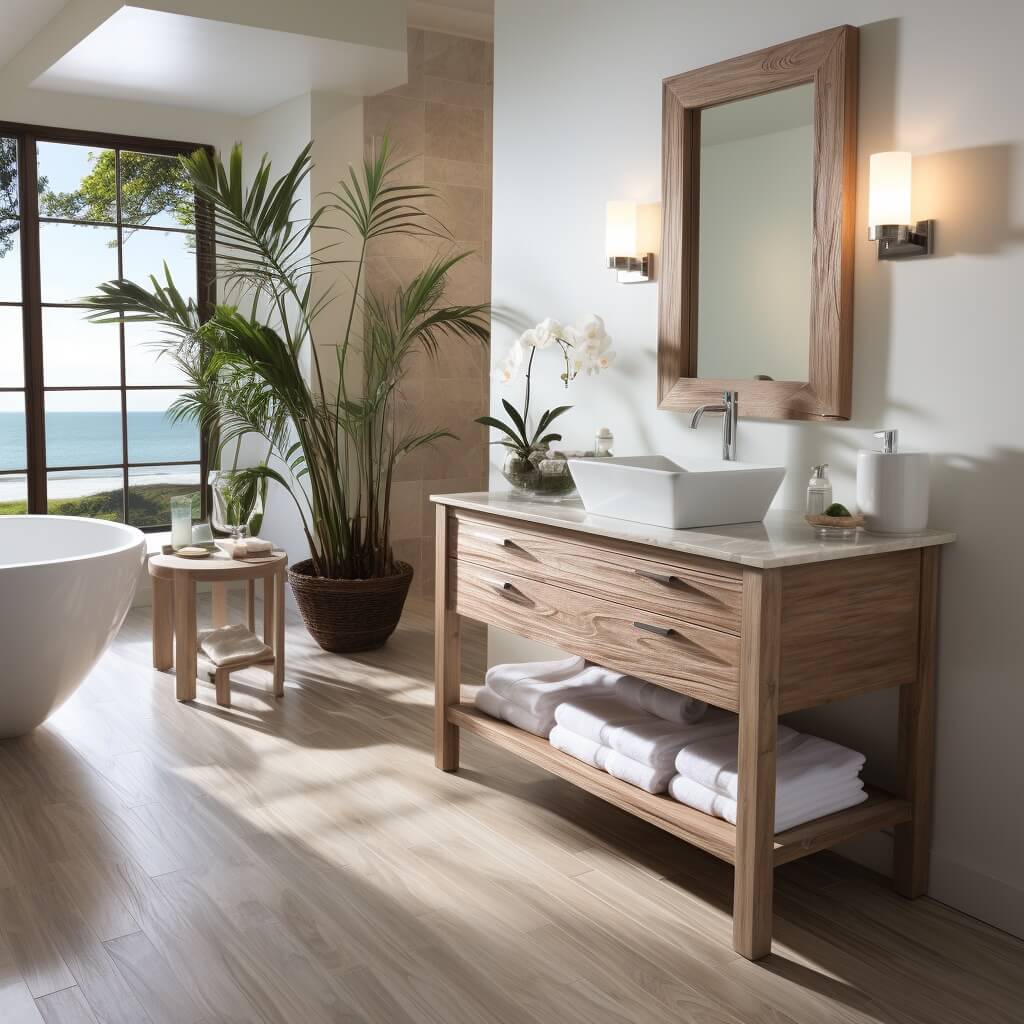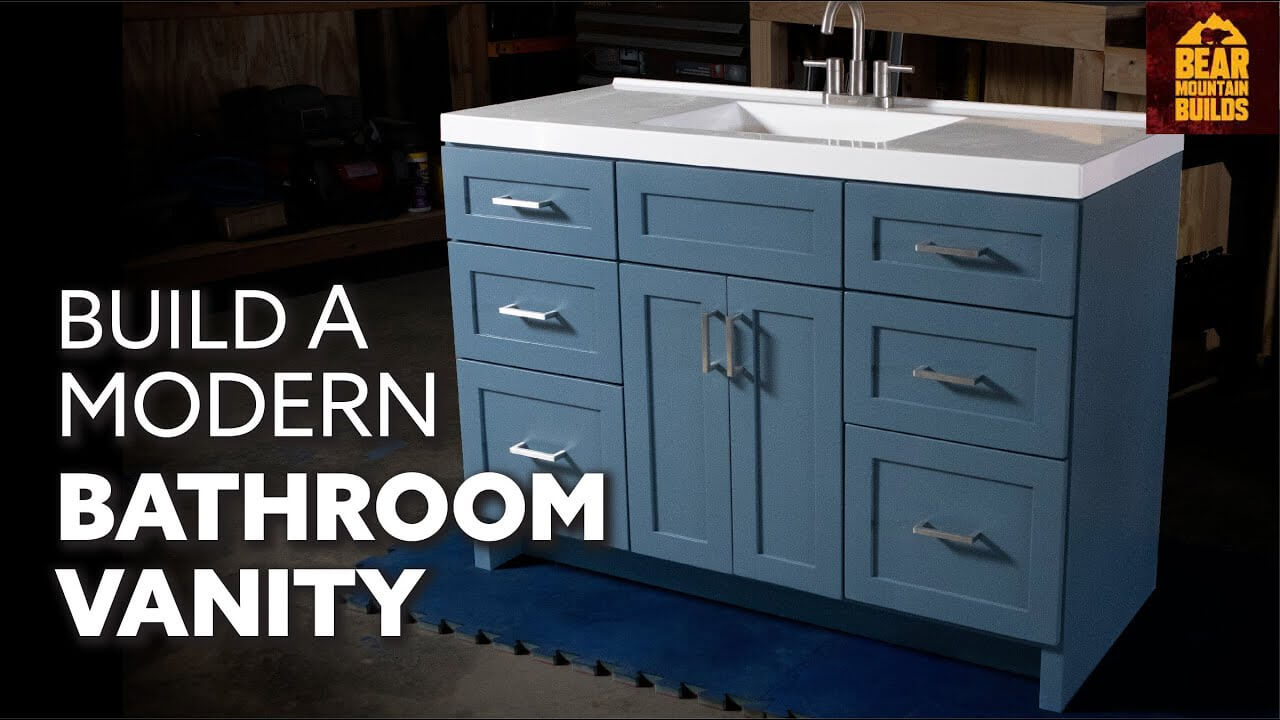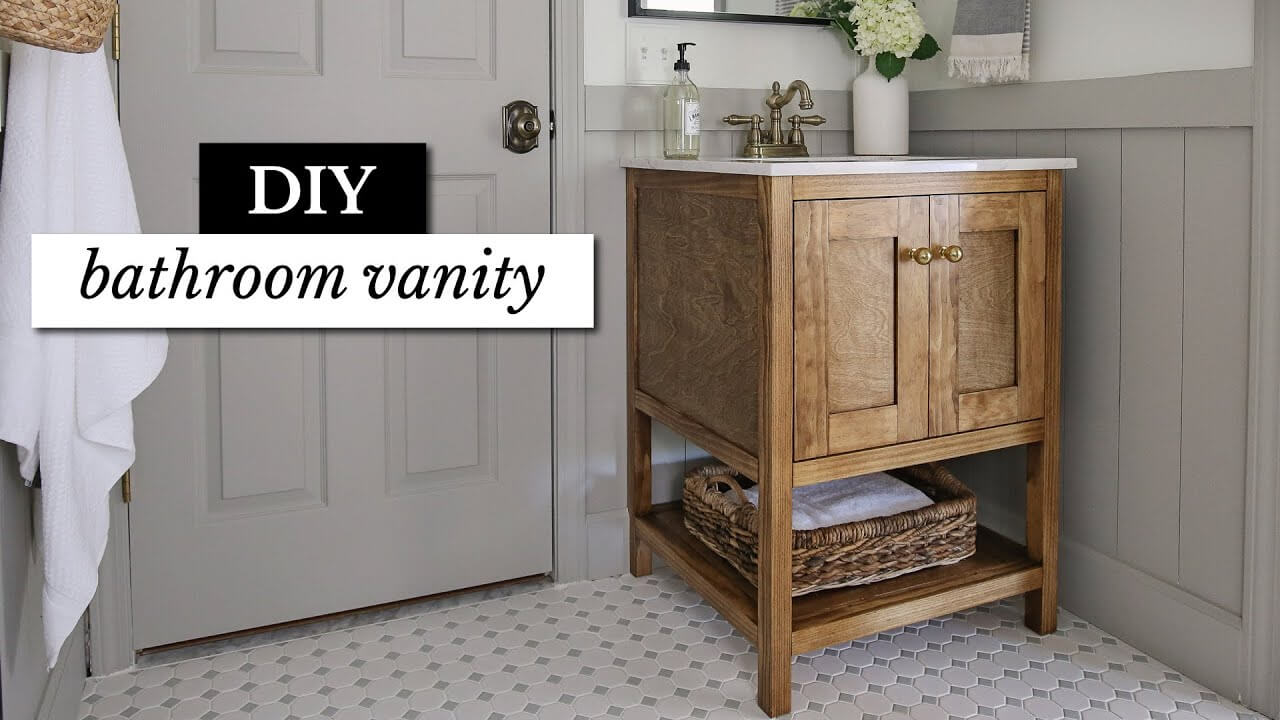Best Wood for Bathroom Vanity and Cabinets
Drawing from my experience as a professional carpenter, assembling and installing bathrooms in homes, I’ve come to appreciate the crucial role that the right materials play in any project.
When it comes to bathroom fixtures, the choice of wood can make a world of difference in both aesthetics and durability of your vanity and cabinets. Looking for the best wood for your bathroom vanity and cabinets? Well, it really depends on your specific needs and style. But don’t worry, we’ve got you covered. Some top contenders include teak, maple, oak, and pine.
In this article, we’ll explore the unique characteristics of these and other popular wood types, aiming to help you make an informed decision for your next bathroom renovation project. So, are you ready? Let’s dive in!
Best Wood for Bathroom Vanity
Each of these wood types offer distinct advantages that make them particularly suited to withstand the humid environment of a bathroom while adding a touch of elegance. Let’s delve deeper into why these woods are the top choices for bathroom vanities.
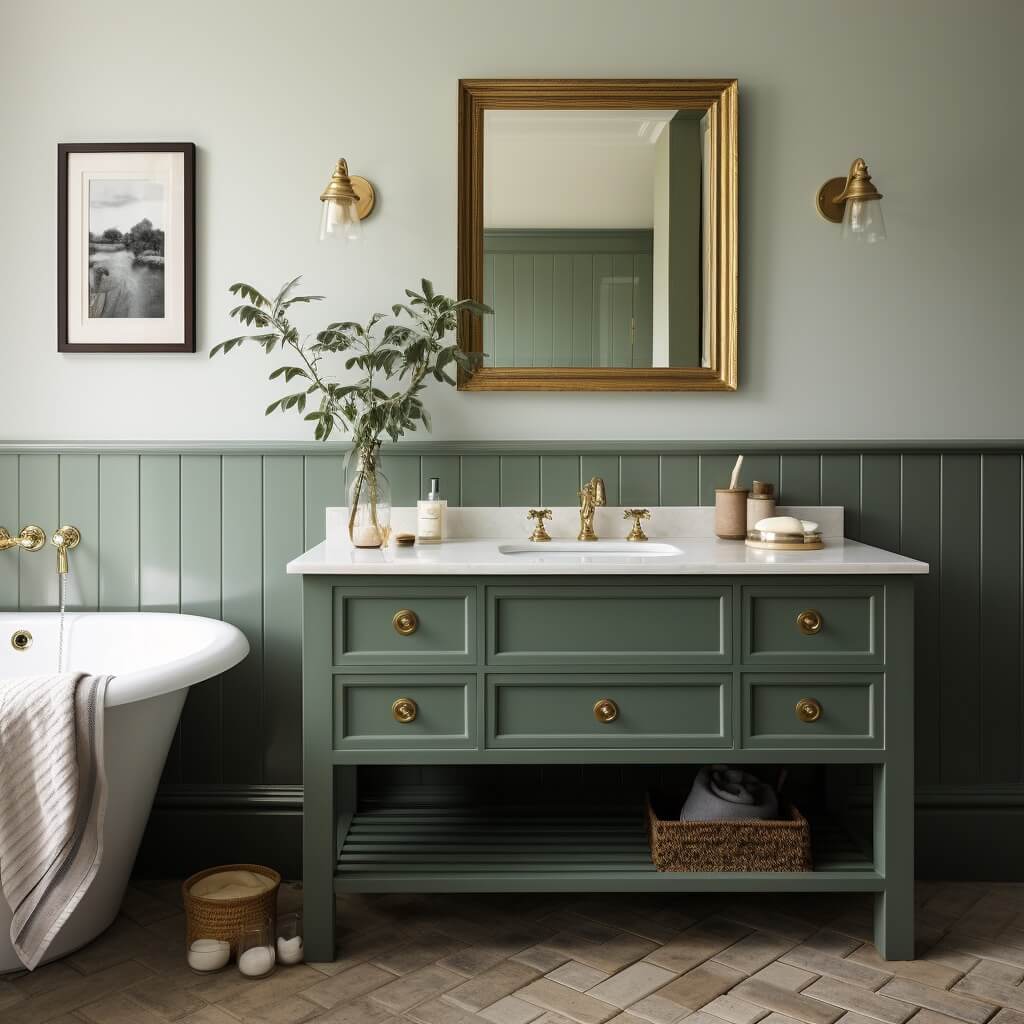
1 | Teak
I’ve found that teak is an exceptional choice for a bathroom vanity. One of the reasons I favor it is its natural resistance to moisture, which is ideal for the humid environment of a bathroom. Its durability is also impressive. I’ve seen teak stand up to daily use without warping, cracking, or splitting. And the aesthetic appeal of teak is undeniable. Its beautiful grain pattern and warm color can effortlessly complement a variety of bathroom designs, adding a touch of elegance and sophistication.
I won’t deny it – teak can be more expensive than some other wood options. But in my experience, the investment is well worth it. The unmatched durability and water resistance of teak make it a cost-effective choice in the long run. Plus, the fact that teak is often sourced from sustainable plantations means that choosing it for your bathroom vanity is also a responsible choice. I’ve found teak easy to work with, whether for professional or DIY projects. It pairs well with various hardware types, making it a versatile choice for any bathroom design.
| Wood Characteristics | Teak for Bathroom Vanity Details |
|---|---|
| Wood Type | Teak Hardwood (Teak Tree) |
| Scientific Name | Tectona grandis |
| Wood Grain | Straight, occasionally wavy or interlocked |
| Wood Density (lb/ft³, kg/m³) | 40.9 lbs/ft³ (655 kg/m³) |
| Wood Janka Scale | 1,070 lbf (pound-force) |
| Wood Stability | Very stable, with excellent resistance to warping and shrinking |
| Wood Finish | Accepts finishes well, may require a solvent wipe prior to finishing due to natural oils |
| Wood Sustainability | Grown on plantations throughout tropical regions, but recent sanctions on imported teak due to human rights violations in Myanmar |
| Wood Cost | One of the most expensive lumbers on the market due to high demand |
| Moisture Content | Not specified |
| Shrinkage | Radial: 2.6%, Tangential: 5.3%, Volumetric: 7.2%, T/R Ratio: 2 |
| Average Dried Weight (lb/ft³, kg/m³) | 40.9 lbs/ft³ (655 kg/m³) |
| Build vs Buy Cost | |
| DIY Bathroom Vanity Cost | $450 – $2,200 (varies depending on materials, tools, and design complexity) |
| Store-Bought Cost | $2,800 – $6,600 (varies depending on materials, tools, and design complexity) |
Teak: MINI-SUMMARY & IDEAL Application
- Ideal Bathroom Setting: Teak is versatile and fits well in both modern and traditional bathroom settings. Its rich, golden-brown hue and straight grain pattern add a touch of elegance and warmth. It’s particularly well-suited for bathrooms with a spa or tropical theme, given its exotic origins.
- Finishing Options: Teak can be left in its natural state to showcase its beautiful color and grain. Alternatively, it can be stained or sealed to enhance its color or protect it further from moisture. A clear, water-resistant finish can help maintain the wood’s natural beauty while providing additional protection.
- Features & Benefits: Teak offers numerous benefits for bathroom vanities. Its natural water resistance makes it less likely to warp or crack in a humid environment. It’s also very durable, ensuring your vanity will last for years to come. Plus, teak’s natural oils repel pests, adding to its longevity. Finally, teak’s luxurious appearance can add a touch of sophistication to any bathroom.
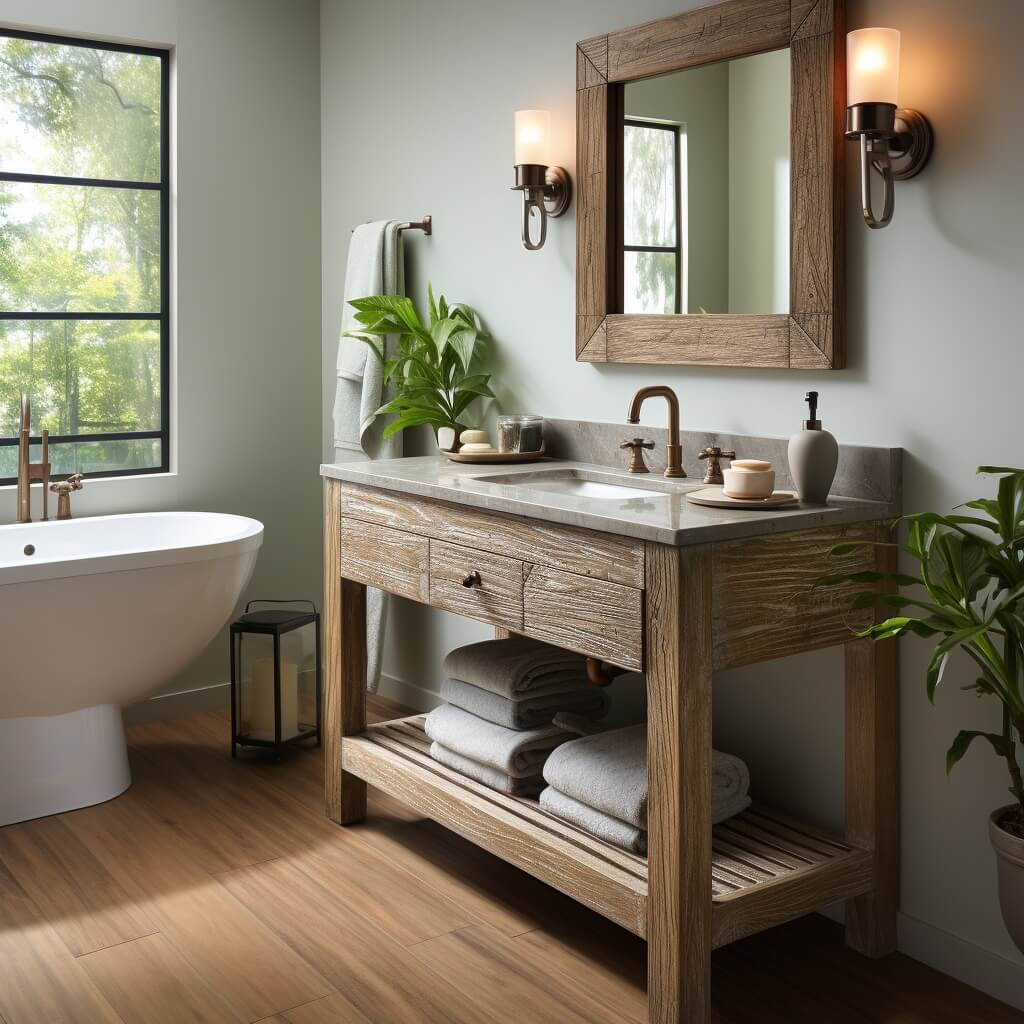
Pros
Cons
2 | White Oak
White oak is another excellent choice for a bathroom vanity that I’ve come to appreciate. It’s a hardwood that’s known for its strength and durability, which are essential in a bathroom setting. I’ve seen white oak resist warping and rotting, which are common issues in a humid environment. The warm glow it emits enriches the surroundings, making it a visually appealing option.
However, white oak does require a bit more care and maintenance. But in my view, the effort is worth it. The wood’s ability to withstand light scratches and dents and its compatibility with any color scheme make it a versatile choice. Despite the need for a bit more upkeep, the resilience and aesthetic appeal of white oak make it a worthy contender for your bathroom vanity.
| Wood Characteristics | White Oak for Bathroom Vanity Details |
|---|---|
| Wood Type | White Oak Hardwood (White Oak Tree) |
| Scientific Name | Quercus alba |
| Wood Grain | Straight and coarse |
| Wood Density (lb/ft³, N/m³) | 47 lbs/ft³ (755 kg/m³) |
| Wood Janka Scale | 1,350 lbf (pound-force) |
| Wood Stability | Stable, with good resistance to warping and shrinking |
| Wood Finish | Accepts stains and finishes well; also suitable for painting |
| Wood Sustainability | Not listed in the CITES Appendices, reported by the IUCN as being a species of least concern |
| Wood Cost | Slightly more expensive than red oak, prices are moderate for a domestic hardwood |
| Moisture Content | Not specified |
| Shrinkage | Radial: 5.6%, Tangential: 10.5%, Volumetric: 16.3%, T/R Ratio: 1.9 |
| Average Dried Weight (lb/ft³, kg/m³) | 47 lbs/ft³ (755 kg/m³) |
| Build vs Buy Cost | Not specified |
| DIY Bathroom Vanity Cost | $300 – $1300 (varies depending on materials, tools, and design complexity) |
| Store-Bought Cost | $1200 – $2,800 (varies depending on materials, tools, and design complexity) |
White Oak: MINI-SUMMARY & IDEAL Application
- Ideal Bathroom Setting: White Oak’s light to medium brown color with an olive cast can add a warm and rustic charm to your bathroom. Its durability and water resistance make it an excellent choice for bathrooms where humidity and water exposure are a given. Whether you’re going for a modern, sleek look or a more traditional, rustic design, White Oak can fit seamlessly into your bathroom decor.
- Finishing Options: White Oak produces good results with both hand and machine tools. It responds well to steam-bending, glues, stains, and finishes well. However, it can react with iron, particularly when wet, causing staining and discoloration. Therefore, it’s essential to choose the right kind of fixtures and fittings to go with your White Oak vanity.
- Features & Benefits: White Oak is not only aesthetically pleasing but also practical. It’s rated as very durable, making it a long-lasting choice for your bathroom vanity. It has moderately high shrinkage values, resulting in mediocre dimensional stability, especially in flatsawn boards. However, its resistance to rot and decay, coupled with its appealing grain and texture, make it a popular choice for bathroom vanities.
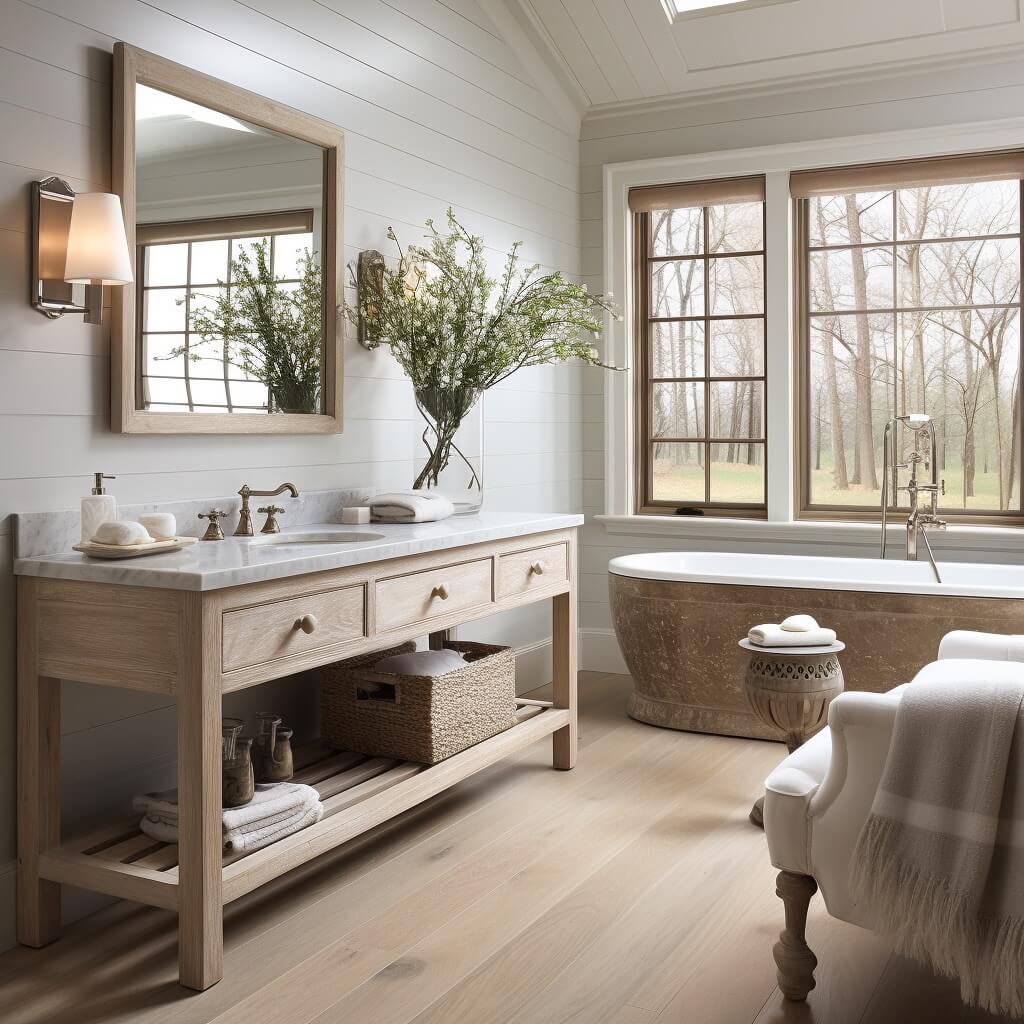
Pros
Cons
3 | MDF
MDF, or Medium-Density Fiberboard, is a material I’ve often turned to for bathroom vanities. It’s an engineered wood product made from broken-down wood fibers bound using wax and resin glue. One of the things I appreciate about MDF is its cost-effectiveness. It’s one of the most budget-friendly options out there, making it a great choice if you’re looking to save on costs.
But don’t let its affordability fool you. MDF can be quite durable and versatile. It takes well to dowels and can be laminated for added strength. Plus, it’s easy to apply any type of finish, paint, or stain on MDF boards because it has no splints on its edges. However, it’s worth noting that if a low-grade MDF is used, the panels may swell and show cracks when subjected to a moist and wet environment for a long time. Despite this, with proper care and maintenance, MDF can be a practical and economical choice for your bathroom vanity.
| Wood Characteristics | MDF for Bathroom Vanity Details |
|---|---|
| Wood Type | Engineered Wood (Medium-Density Fibreboard) |
| Scientific Name | Not applicable |
| Wood Grain | No natural grain pattern due to its composition |
| Wood Density (lb/ft³, N/m³) | 40-50 lb/ft³ (641-801 kg/m³) |
| Wood Janka Scale | Not applicable due to its engineered nature |
| Wood Stability | Stable, with good resistance to warping and shrinking |
| Wood Finish | Accepts paints and veneers well; not suitable for staining |
| Wood Sustainability | Made from recycled wood fibers and resin; sustainability varies based on manufacturing practices |
| Wood Cost | Affordable compared to most solid woods |
| Moisture Content | Not applicable due to its engineered nature |
| Shrinkage | Minimal due to its engineered nature |
| Average Dried Weight (lb/ft³, kg/m³) | Not applicable due to its engineered nature |
| Build vs Buy Cost | |
| DIY Vanity Cost | $100 – $300 (varies depending on materials, tools, and design complexity) |
| Store-Bought Cost | $600 – $2,500 (varies depending on brand, materials, and design) |
MDF: MINI-SUMMARY & IDEAL Application
- Ideal Bathroom Setting: MDF is an excellent choice for bathrooms where budget is a primary concern. Its smooth surface and uniformity allow for a wide range of finishes, making it adaptable to various bathroom styles. However, it’s important to note that MDF is not as resistant to moisture and humidity as solid wood or plywood, so it may not be the best choice for bathrooms with high humidity levels unless properly sealed and maintained.
- Finishing Options: MDF takes well to paint, making it a great choice for those who want a custom color for their bathroom vanity. It can also be veneered to give the appearance of natural wood. However, MDF should be properly sealed and finished, especially in a bathroom setting, to protect it from moisture and ensure its longevity.
- Features & Benefits: MDF is a cost-effective choice for bathroom vanities. It offers a smooth surface and consistent texture, making it easy to work with and finish. However, it’s less resistant to moisture and humidity than other materials, so it requires proper sealing and maintenance to prevent swelling or warping. Despite this, its affordability and versatility make it a popular choice for bathroom vanities.
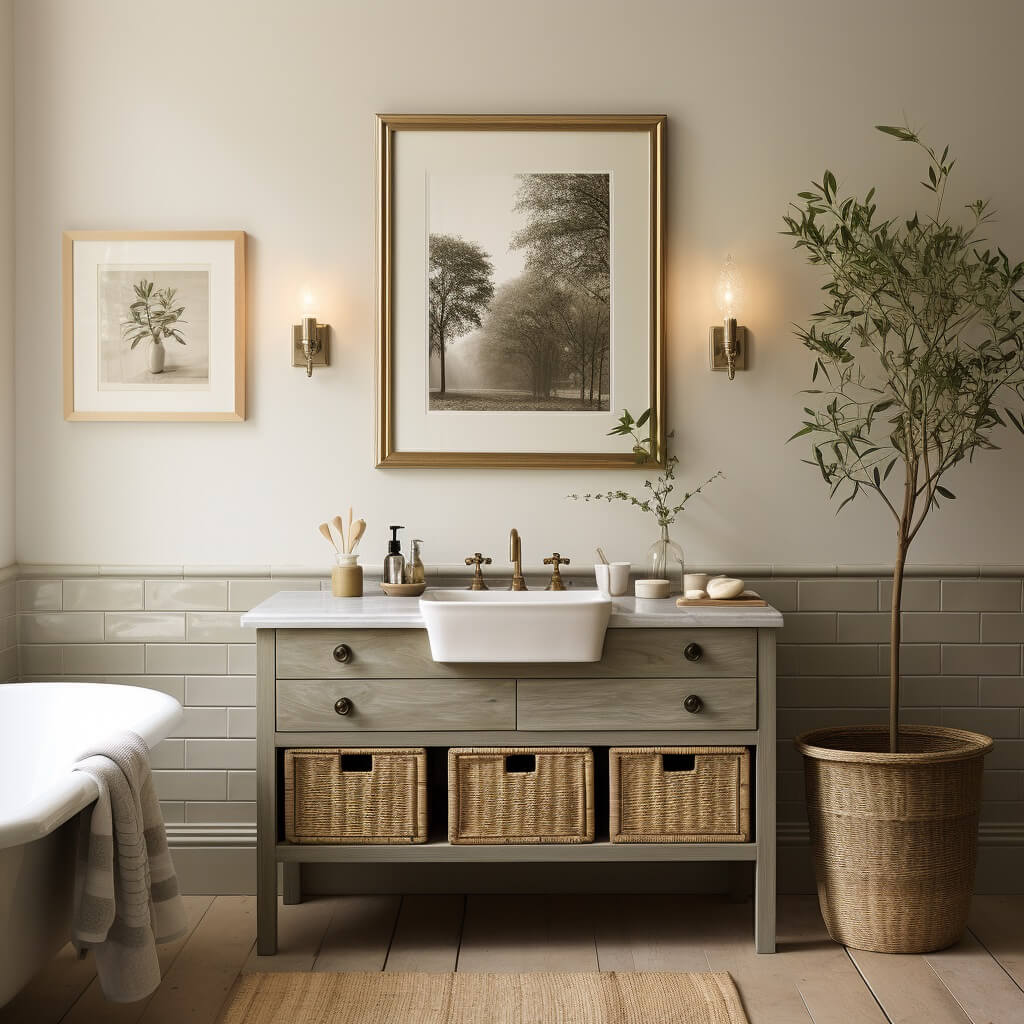
Pros
Cons
4 | Maple
Maple is a wood type that I’ve found to be a fantastic choice for bathroom vanities, and that not just because of it’s beauty. Its resistance to water, rot, insects, and decay due to its durability makes it a reliable choice for a bathroom setting. I’ve worked with maple wood quite a bit and its straight grain makes it a joy to work with.
One of the things I love about maple is its compatibility with wood glues, stains, and finishes. This means you can easily adapt it to fit a modern or traditional theme in your bathroom. Soft maple is readily available in the market at a reasonable cost, making it a great option if you’re looking for a balance between cost and quality. While hard maple wood tends to be more expensive than soft maple wood, both types offer a beautiful and durable option for your bathroom vanity.
| Wood Characteristics | Maple for Bathroom Vanity Details |
|---|---|
| Wood Type | Maple Hardwood (Maple Tree) |
| Scientific Name | Acer saccharum |
| Wood Grain | Generally straight, but may be wavy. Has a fine, even texture. |
| Wood Density (lb/ft³, N/m³) | 44 lb/ft³ (705 kg/m³) |
| Wood Janka Scale | 1450 lbf (pound-force) |
| Wood Stability | Good stability, with less shrinking or swelling compared to other hardwoods. |
| Wood Finish | Can be stained or polished to an excellent finish. |
| Wood Sustainability | Widely available as both lumber and veneer. |
| Wood Cost | Moderate for regular Maple, more expensive for figured (curly) Maple. |
| Moisture Content | 6-8% (kiln-dried) |
| Shrinkage | Radial: 4.8%, Tangential: 9.9%, Volumetric: 14.7%, T/R Ratio: 1.9 |
| Average Dried Weight (lb/ft³, kg/m³) | 44 lbs/ft³ (705 kg/m³) |
| Build vs Buy Cost | |
| DIY Bathroom Vanity Cost | $200 – $1000 (varies depending on materials, tools, and design complexity) |
| Store-Bought Cost | $2,000 – $5,000 (varies depending on brand, materials, and design) |
Maple: MINI-SUMMARY & IDEAL Application
- Ideal Bathroom Setting: Maple’s strength and durability make it an excellent choice for bathroom vanities that need to withstand daily use. Its light color can brighten up a bathroom and matches well with various styles and decors. However, it’s important to note that maple is rated as non-durable to perishable and susceptible to insect attack, so it should be properly sealed and maintained, especially in a bathroom setting.
- Finishing Options: Maple can be finished in a variety of ways. It can be stained to enhance its natural color or painted for a more customized look. It’s also known to finish well with clear coats, which can highlight its natural grain patterns. However, blotches can occur when staining, so a pre-conditioner, gel stain, or toner may be necessary to achieve an even color.
- Features & Benefits: Maple is a strong, stiff, and dense wood, making it a durable choice for bathroom vanities. It’s also fairly easy to work with, both with hand and machine tools, although it can burn when machined with high-speed cutters. Despite these challenges, its natural beauty and durability make it a popular choice for bathroom vanities.
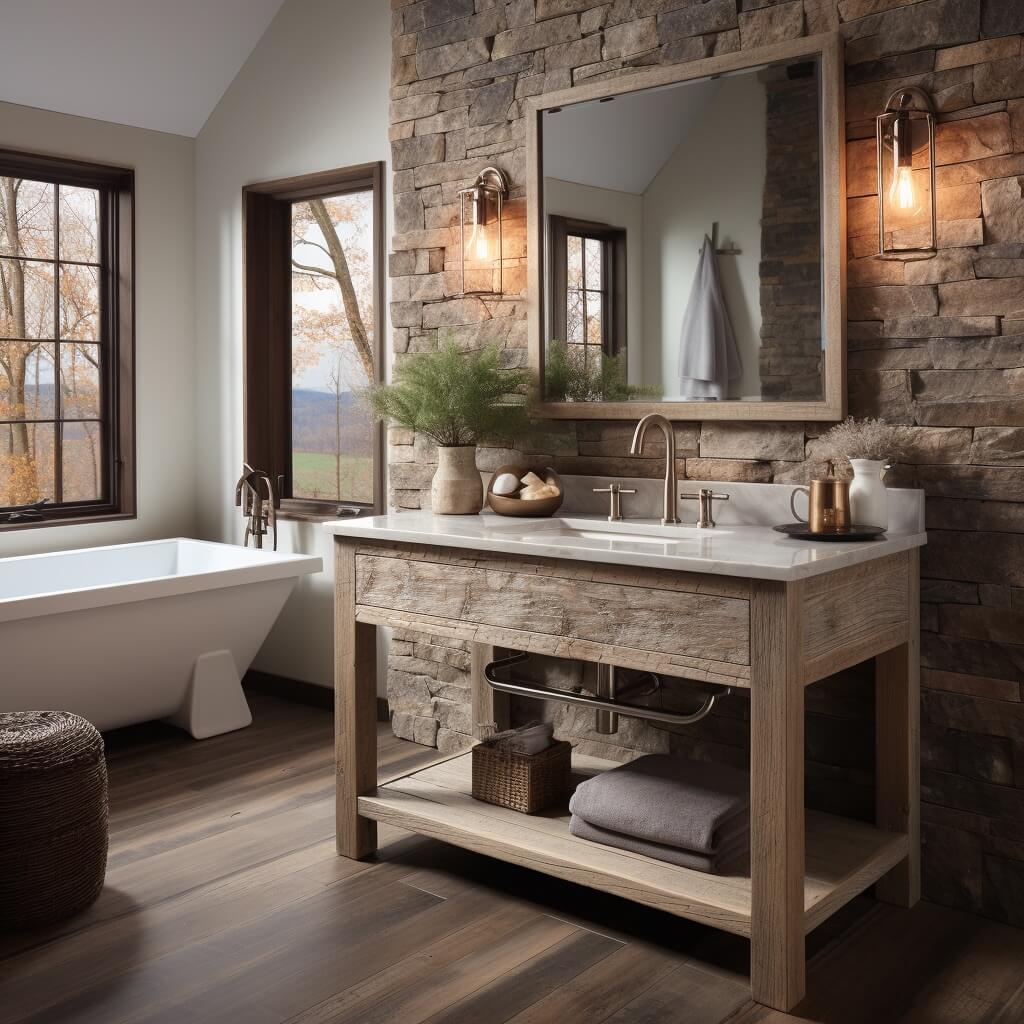
Pros
Cons
5 | Douglas Fir
Douglas fir is another wood type that I’ve found to be a solid choice for bathroom vanities. It’s a type of fir that’s readily available in the market, making it a convenient option. One of the things I’ve noticed about Douglas fir is its good bonding properties with different kinds of glues and adhesives, which can be a significant advantage during assembly.
What sets Douglas fir apart is its strength and workability. It’s a wood that’s known for its durability, and it tends to dry faster with minimum deviations, which is a big plus in a bathroom setting. That said, it does require regular maintenance to maintain its look. Despite this, the softness of the wood can make it prone to cracks and dents, so it’s important to handle it with care. But with proper maintenance, Douglas fir can be a great, readily available lumber for your bathroom vanity.
| Wood Characteristics | Douglas Fir for Bathroom Vanity Details |
|---|---|
| Wood Type | Douglas Fir Softwood (Douglas Fir) |
| Scientific Name | Pseudotsuga menziesii |
| Wood Grain | Generally straight, or slightly wavy. Medium to coarse texture, with moderate natural luster. |
| Wood Density (lb/ft³, N/m³) | 32 lb/ft³ (510 kg/m³) |
| Wood Janka Scale | 620 lbf (pound-force) |
| Wood Stability | Good stability, with less shrinking or swelling compared to other hardwoods. |
| Wood Finish | Typically machines well, but has a moderate blunting effect on cutters. Accepts stains, glues, and finishes well. |
| Wood Sustainability | This wood species is not listed in the CITES Appendices, and is reported by the IUCN as being a species of least concern. |
| Wood Cost | Should be widely available as construction lumber for a modest price. Old growth or reclaimed boards can be much more expensive. |
| Moisture Content | 12-15% (kiln-dried) |
| Shrinkage | Radial: 4.5%, Tangential: 7.3%, Volumetric: 11.6%, T/R Ratio: 1.6 |
| Average Dried Weight (lb/ft³, kg/m³) | 32 lbs/ft³ (510 kg/m³) |
| Build vs Buy Cost | |
| DIY Bathroom Vanity Cost | $180 – $1300 (varies depending on materials, tools, and design complexity) |
| Store-Bought Cost | $1400 – $3,000 (varies depending on materials, tools, and design complexity) |
Douglas Fir: MINI-SUMMARY & IDEAL Application
- Ideal Bathroom Setting: Douglas Fir, with its light brown color and a hint of red and/or yellow, can add a warm and natural aesthetic to your bathroom. Its grain is generally straight or slightly wavy, offering a medium to coarse texture with a moderate natural luster. This makes it an excellent choice for a rustic or traditional bathroom setting.
- Finishing Options: Douglas Fir machines well and accepts stains, glues, and finishes well. This allows for a wide range of finishing options to match your bathroom decor. However, it does have a moderate blunting effect on cutters, so care should be taken during the finishing process.
- Features & Benefits: Douglas Fir is a strong and durable wood, making it a reliable choice for a bathroom vanity. It’s not listed in the CITES Appendices and is reported by the IUCN as being a species of least concern, making it a sustainable choice. The wood is widely available as construction lumber at a modest price, although old growth or reclaimed boards can be more expensive.
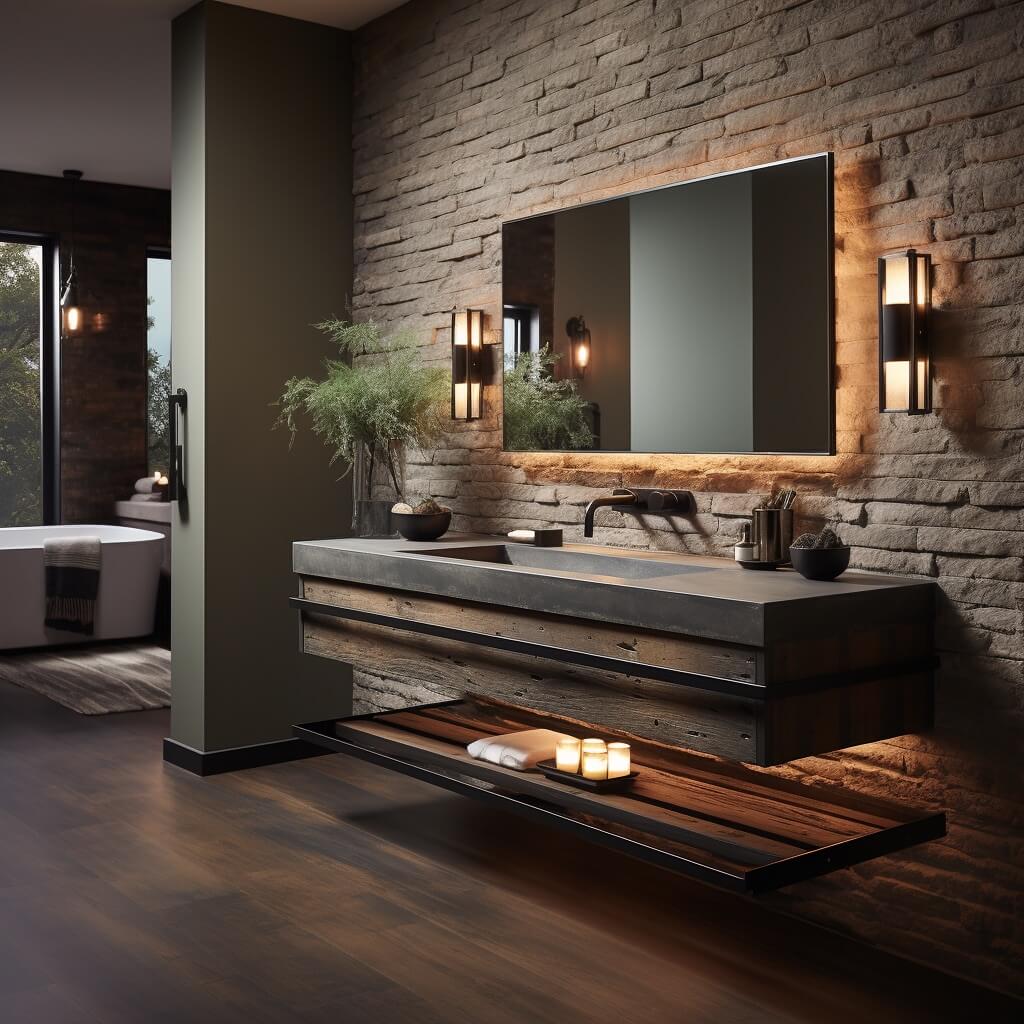
Pros
Cons
6 | Mahogany
Mahogany is a wood type that I hold in high regard, especially when it comes to bathroom vanities. Its beauty and durability make it a highly sought-after choice. One of the standout features of mahogany is its excellent water resistance. It takes negligible or less damage due to humidity and moisture, which is a significant advantage in a bathroom setting. Additionally, mahogany requires a simple clean-up routine, which doesn’t have a detrimental effect on the wood, making maintenance a breeze.
Mahogany is also resistant to warping, a common issue with wood in fluctuating temperatures and humidity levels. This resilience adds to its appeal. Plus, mahogany comes in multiple color variants, providing plenty of options to match your bathroom’s aesthetic. While the demand for mahogany is high, leading to higher prices, I believe the investment is worth it for the quality and durability you get. If you’re looking for a high-end, resilient wood for your bathroom vanity, mahogany is a choice worth considering.
| Wood Characteristics | Mahogany for Bathroom Vanity Details |
|---|---|
| Wood Type | Mahogany Hardwood (African Mahogany) |
| Scientific Name | Khaya spp. (primarily A. anthotheca and A. ivorensis) |
| Wood Grain | Straight to interlocked, medium to coarse texture. Good natural luster with a high degree of chatoyancy. |
| Wood Density (lb/ft³, N/m³) | 33.9 lbs/ft³ (545 kg/m³) |
| Wood Janka Scale | 850 lbf (pound-force) |
| Wood Stability | Good stability, with less shrinking or swelling compared to other hardwoods. |
| Wood Finish | Generally easy to work, though tearout can be a problem if the grain is interlocked. May stain and react with iron-based fasteners in damp conditions. Glues, turns, and finishes well. |
| Wood Sustainability | Listed in CITES Appendix II, IUCN Red List. Each primary Khaya species is listed as vulnerable due to a population reduction of over 20% in the past three generations, caused by a decline in its natural range, and exploitation. |
| Wood Cost | Available in a variety of lumber sizes, as well as plywood and veneer. Prices are moderate for an imported hardwood. |
| Moisture Content | 12% (kiln-dried) |
| Shrinkage | Radial: 3.4%, Tangential: 5.7%, Volumetric: 9.3%, T/R Ratio: 1.7 |
| Average Dried Weight (lb/ft³, kg/m³) | 33.9 lbs/ft³ (545 kg/m³) |
| Build vs Buy Cost | |
| DIY Bathroom Vanity Cost | $450 – $2,600 (varies depending on materials, tools, and design complexity) |
| Store-Bought Cost | $2,000 – $8,000 (varies depending on materials, tools, and design complexity) |
Mahogany : MINI-SUMMARY & IDEAL Application
- Ideal Bathroom Setting: African Mahogany is versatile, fitting various bathroom styles. Its heartwood, ranging from pale pink to deeper reddish-brown, darkens over time, adding warmth and luxury. Its straight to interlocked grain, medium to coarse texture, and high chatoyancy make it suitable for an elegant bathroom.
- Finishing Options: African Mahogany is generally easy to work with, though tearout can be a problem if the grain is interlocked. It may stain and react with iron-based fasteners in damp conditions. However, it glues, turns, and finishes well, offering a wide range of finishing options to match your bathroom decor.
- Features & Benefits: African Mahogany is strong and durable, a reliable choice for a bathroom vanity. However, it’s listed in CITES Appendix II, and all primary Khaya species are on the IUCN Red List, classified as vulnerable due to population reduction caused by exploitation and decline in the natural range. Despite this, African Mahogany is available in various lumber sizes, plywood, and veneer, at moderate prices for imported hardwood.
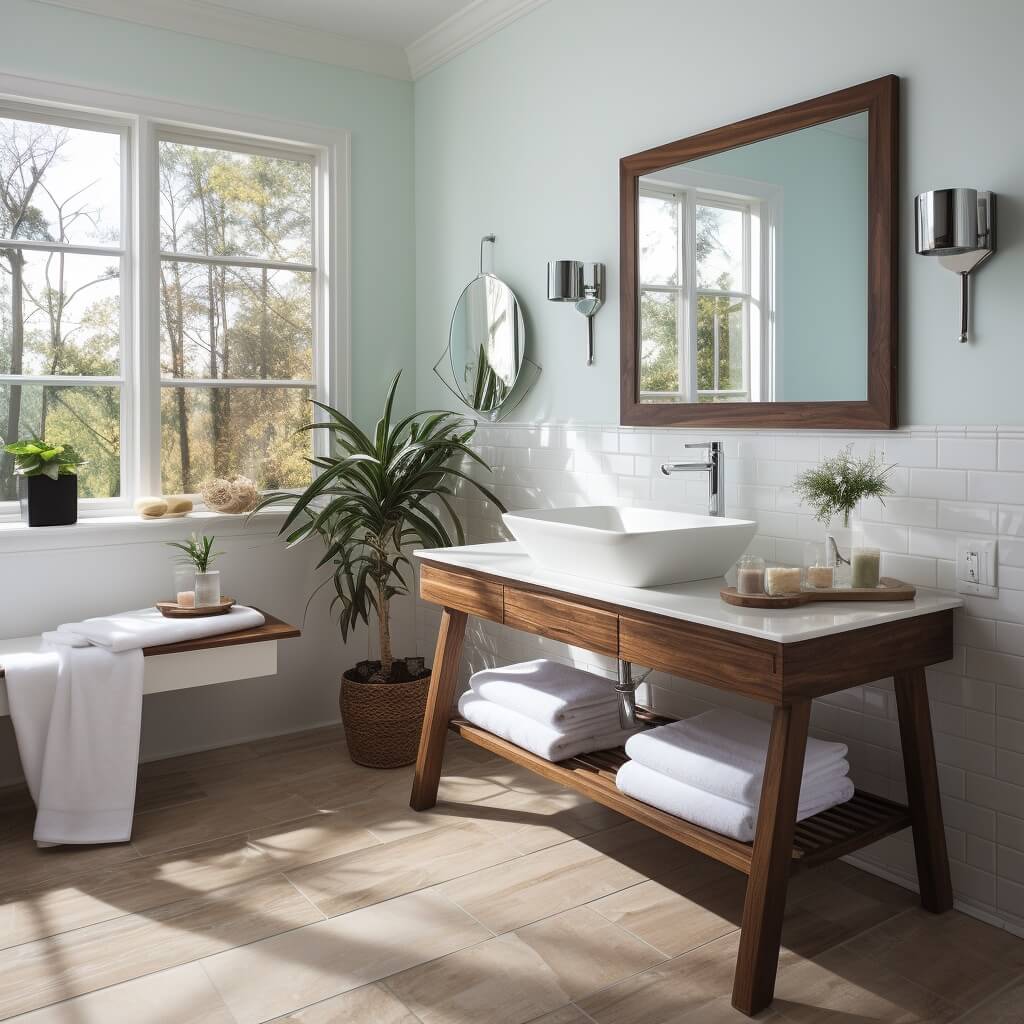
Pros
Cons
7 | Mango Wood
Mango wood has quickly become one of my go-to choices for bathroom vanities. Its strength and lightweight nature make it a joy to work with, especially for DIY projects. This wood is highly responsive to sanding and staining techniques, allowing me to achieve a customized look that perfectly matches any bathroom aesthetic.
What sets mango wood apart is its affordability and sustainability. It’s less costly than many hardwoods, making it a budget-friendly option. Moreover, mango wood is a byproduct of mango trees past their fruit-bearing age, making it a sustainable choice. Note, it’s important to note that mango wood needs proper seasoning to prevent high moisture retention, which could lead to woodworm infestation. With the right care, mango wood can offer a unique blend of beauty, affordability, and sustainability for your bathroom vanity.
| Wood Characteristics | Mango for Bathroom Vanity Details |
|---|---|
| Wood Type | Hardwood (Mango) |
| Scientific Name | Mangifera indica |
| Wood Grain | Straight to interlocked, medium to coarse texture. Good natural luster with a high degree of chatoyancy. |
| Wood Density (lb/ft³, N/m³) | 42.1 lbs/ft³ (675 kg/m³) |
| Wood Janka Scale | 1,070 lbf |
| Wood Stability | Not provided |
| Wood Finish | Generally easy to work, though tearout can be a problem if the grain is interlocked. May stain and react with iron-based fasteners in damp conditions. Glues, turns, and finishes well. |
| Wood Sustainability | This wood species is not listed in the CITES Appendices, but is reported by the IUCN as being data deficient. This is due to the widespread cultivation of the tree. |
| Wood Cost | Available in a variety of lumber sizes, as well as plywood and veneer. Prices are moderate for an imported hardwood. |
| Moisture Content | 10% (kiln-dried) |
| Shrinkage | Radial: 3.6%, Tangential: 5.5%, Volumetric: 8.9%, T/R Ratio: 1.5 |
| Average Dried Weight (lb/ft³, kg/m³) | 42.1 lbs/ft³ (675 kg/m³) |
| Build vs Buy Cost | |
| DIY Bathroom Vanity Cost | $150 – $1600 (varies depending on materials, tools, and design complexity) |
| Store-Bought Cost | $400 – $2,800 (varies depending on materials, tools, and design complexity) |
Mango Wood : MINI-SUMMARY & IDEAL Application
- Ideal Bathroom Setting: Mango wood, a tropical hardwood, offers a unique aesthetic to bathroom vanities with its golden brown heartwood and curly or mottled grain patterns. However, due to its susceptibility to fungal and insect attack, it requires proper sealing and maintenance, especially in damp environments like bathrooms.
- Finishing Options: Mango wood’s medium to coarse texture and good natural luster make it visually appealing for bathroom vanities. Despite its high silica content that can dull cutting edges, it glues and finishes well. A variety of finishes, including oil-based finishes, varnishes, or lacquers, can be applied to enhance its natural beauty and protect it from moisture and damage.
- Features & Benefits: Mango wood is known for its unique color variations and grain patterns, adding elegance and uniqueness to a bathroom vanity. It’s an eco-friendly choice as the wood is harvested from fruit-bearing mango trees. Despite being moderately durable to perishable, with proper care, mango wood can last for years. It’s also less expensive lumber than some other popular hardwoods, making it a cost-effective choice for bathroom vanities.
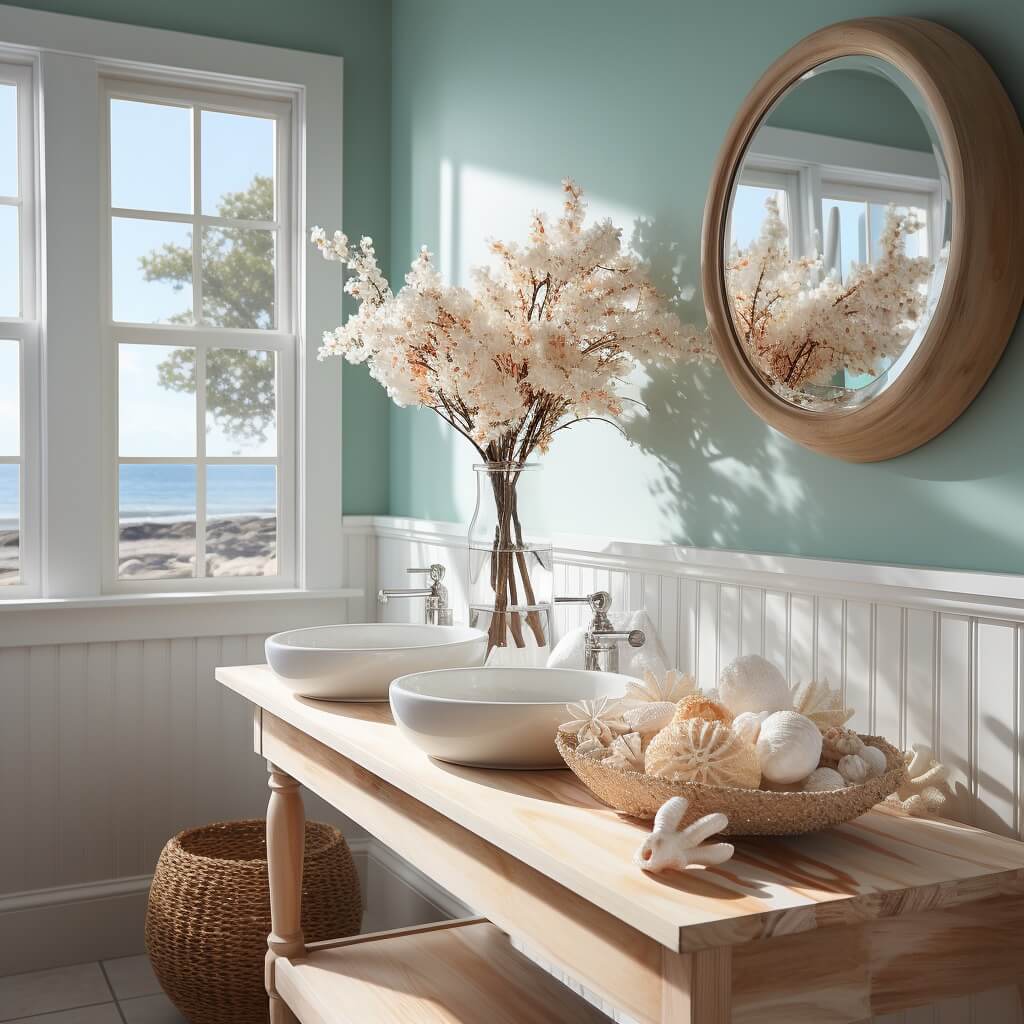
Pros
Cons
8 | Pine
Pine is another wood type that I often recommend for bathroom vanities. It’s a softwood that offers a unique blend of affordability and natural beauty. Pine’s warm and rustic patina, which it acquires with age, can add a charming touch to any bathroom.
One of the advantages of pine is its adaptability. It accepts different stains and paints well, allowing for a high degree of customization. Plus, pine has properties that can resist the shrinking and swelling often associated with changes in humidity. However, it’s worth noting that pine is softer than many other woods, making it more vulnerable to scratches and dents. With careful handling and maintenance, pine can be a cost-effective and aesthetically pleasing choice for your bathroom vanity.
| Wood Characteristics | Pine for Bathroom Vanity Details |
|---|---|
| Wood Type | Pine Softwood (Eastern White Pine) |
| Scientific Name | Pinus strobus |
| Wood Grain | Straight with an even, medium texture. |
| Wood Density (lb/ft³, N/m³) | 25 lbs/ft³ (400 kg/m³) |
| Wood Janka Scale | 380 lbf |
| Wood Stability | Not provided |
| Wood Finish | Easy to work, glues, turns, and finishes well. |
| Wood Sustainability | Not listed in CITES Appendices, reported by the IUCN as being a species of least concern. |
| Wood Cost | Widely harvested for construction lumber, prices should be moderate. |
| Moisture Content | 15% (kiln-dried) |
| Shrinkage | Radial: 2.1%, Tangential: 6.1%, Volumetric: 8.2%, T/R Ratio: 2.9 |
| Average Dried Weight (lb/ft³, kg/m³) | 25 lbs/ft³ (400 kg/m³) |
| Build vs Buy Cost | |
| DIY Bathroom Vanity Cost | $65 – $1100 (varies depending on materials, tools, and design complexity) |
| Store-Bought Cost | $600 – $3,000 (varies depending on materials, tools, and design complexity) |
Pine : MINI-SUMMARY & IDEAL Application
- Ideal Bathroom Setting: Pine, particularly Eastern White Pine, is a softwood that can bring a rustic charm to your bathroom vanity. Its heartwood is light brown, sometimes with a slightly reddish hue, and the sapwood is pale yellow to nearly white. The grain is straight, providing a uniform look that can fit into a variety of bathroom styles. However, it’s important to note that pine is rated as moderate to low in decay resistance, so it may not be the best choice for damp environments like bathrooms unless properly sealed and maintained.
- Finishing Options: Eastern White Pine has an even, medium texture and a faint, resinous odor while being worked. It is easy to work with both hand and machine tools, and it glues and finishes well. Therefore, a variety of finishes can be applied to enhance its natural beauty and protect it from moisture and damage. These could include oil-based finishes, varnishes, or lacquers.
- Features & Benefits: Eastern White Pine is widely harvested for construction lumber, making it a cost-effective choice for bathroom vanities. It’s also considered an eco-friendly choice as it is reported by the IUCN as being a species of least concern. Despite being moderate to low in decay resistance, with proper care, pine can last for years. Its unique color variations and grain patterns can add a touch of rustic charm to a bathroom vanity.
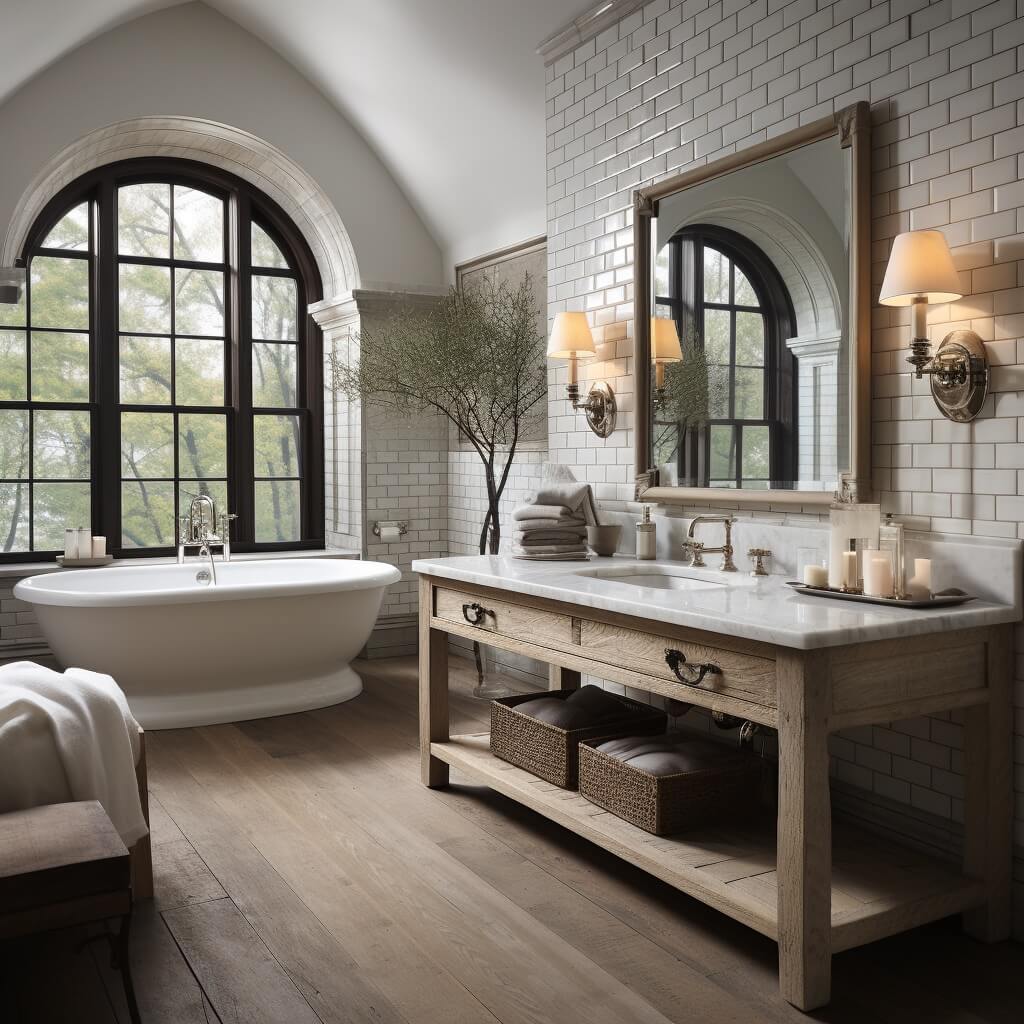
Pros
Cons
9 | Elm
Elm is a type of wood that I find particularly appealing for bathroom vanities. Despite being a hardwood, elm has a softness to it that gives it a unique texture and feel. Its reddish-brown color, coarse and uneven appearance, and beautiful grain pattern can add a distinctive touch to your bathroom.
What I appreciate about elm is its combination of softwood and hardwood qualities. It’s resistant to splitting thanks to its interlocked grain texture, and it holds well with nails and screws, making assembly a breeze. Elm is also moderately priced, making it a good option if you’re looking for a balance between cost and quality. Although, it’s worth noting that elm is more susceptible to insect attacks than some other woods. With proper treatment and maintenance, elm can be a unique and attractive wood for your bathroom vanity.
| Wood Characteristics | Elm for Bathroom Vanity Details |
|---|---|
| Wood Type | Elm Hardwood (English Elm) |
| Scientific Name | Ulmus procera |
| Wood Grain | Interlocked, medium to coarse texture. Good natural luster. |
| Wood Density (lb/ft³, N/m³) | 35 lbs/ft³ (565 kg/m³) |
| Wood Janka Scale | 810 lbf |
| Wood Stability | Not provided |
| Wood Finish | Easy to work, glues, turns, and finishes well. |
| Wood Sustainability | Not listed in CITES Appendices, reported by the IUCN as being data deficient. |
| Wood Cost | Available in a variety of lumber sizes, moderate prices for an imported hardwood. |
| Moisture Content | 12% (kiln-dried) |
| Shrinkage | Radial: 5.0%, Tangential: 7.0%, Volumetric: 12.2%, T/R Ratio: 1.4 |
| Average Dried Weight (lb/ft³, kg/m³) | 35 lbs/ft³ (565 kg/m³) |
| Build vs Buy Cost | |
| DIY Bathroom Vanity Cost | $400 – $2,400 (varies depending on materials, tools, and design complexity) |
| Store-Bought Cost | $2,000 – $5,500 (varies depending on materials, tools, and design complexity) |
Elm : MINI-SUMMARY & IDEAL Application
- Ideal Bathroom Setting: English Elm, with its light to medium reddish-brown heartwood and interlocked grain, can bring a unique aesthetic to your bathroom vanity. However, it’s worth noting that English Elm is rated as non-durable and susceptible to insect attack. Therefore, it may not be the best choice for damp environments like bathrooms unless the wood is correctly sealed.
- Finishing Options: English Elm has a somewhat coarse, uneven texture, but it glues, stains, and finishes well. Therefore, a variety of finishes can be applied to enhance its natural beauty and protect it from moisture and damage. These could include oil-based finishes, varnishes, or lacquers.
- Features & Benefits: English Elm is known for its unique color variations and grain patterns, which can add a touch of elegance and uniqueness to a bathroom vanity. It’s also considered an eco-friendly choice as it is not listed in the CITES Appendices or on the IUCN Red List of Threatened Species. Despite being non-durable, with proper care, English Elm can last for years. It’s also available in a variety of lumber sizes, as well as plywood and veneer, at moderate prices for an imported hardwood.
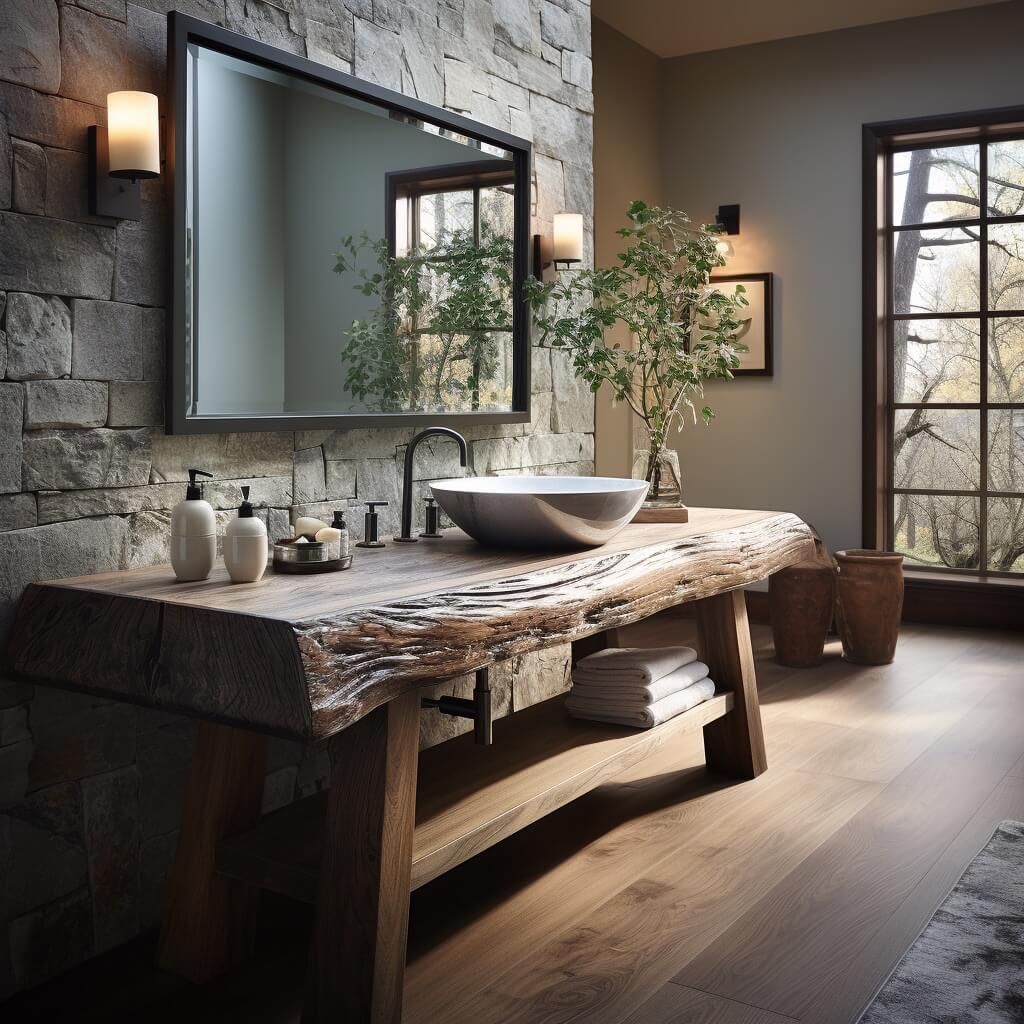
Pros
Cons
10 | Birch
Birch is a hardwood that I often recommend for bathroom vanities. Its pale-white to reddish-brown color and wide availability make it a versatile choice. The straight grains of birch create a beautiful pattern on the wood, adding a touch of elegance to your bathroom.
The cost-effectiveness of birch sets it apart. It’s a more budget-friendly option compared to many hardwoods, making it ideal if you’re mindful of expenses. The ease of working with birch is another advantage. It takes well to stains and polishes, enabling you to achieve a finish that aligns with your vision. However, birch’s hygroscopic nature means it absorbs moisture from the air, which may not be ideal in dry environments. With the right care, birch can offer an attractive, cost-effective solution for your bathroom vanity.
| Wood Characteristics | Birch for Bathroom Vanity Details |
|---|---|
| Wood Type | Birch Hardwood (Yellow Birch) |
| Scientific Name | Betula alleghaniensis |
| Wood Grain | Straight to interlocked, medium to coarse texture. Good natural luster. |
| Wood Density (lb/ft³, N/m³) | 43 lbs/ft³ (690 kg/m³) |
| Wood Janka Scale | 1,260 lbf |
| Wood Stability | Not provided |
| Wood Finish | Easy to work, glues, turns, and finishes well. |
| Wood Sustainability | Not listed in CITES Appendices, reported by the IUCN as being data deficient. |
| Wood Cost | Available in a variety of lumber sizes, moderate prices for an imported hardwood. |
| Moisture Content | 12% (kiln-dried) |
| Shrinkage | Radial: 7.3%, Tangential: 9.5%, Volumetric: 16.8%, T/R Ratio: 1.3 |
| Average Dried Weight (lb/ft³, kg/m³) | 43 lbs/ft³ (690 kg/m³) |
| Build vs Buy Cost | |
| DIY Bathroom Vanity Cost | $200 – $2,000 (varies depending on materials, tools, and design complexity) |
| Store-Bought Cost | $1800 – $6,000 (varies depending on materials, tools, and design complexity) |
Birch: MINI-SUMMARY & IDEAL Application
- Ideal Bathroom Setting: Yellow Birch, with its light reddish-brown heartwood and nearly white sapwood, offers a somewhat uniform, yet dull appearance. Its grain is generally straight or slightly wavy, with a fine, even texture and low natural luster. However, it’s worth noting that Yellow Birch is perishable and can readily rot and decay if exposed to the elements. Therefore, it may not be the best choice for damp environments like bathrooms unless properly sealed and maintained.
- Finishing Options: Yellow Birch is generally easy to work with hand and machine tools, though boards with wild grain can cause grain tearout during machining operations. It turns, glues, and finishes well, making it a versatile choice for bathroom vanities. A variety of finishes can be applied to enhance its natural beauty and protect it from moisture and damage. These could include oil-based finishes, varnishes, or lacquers.
- Features & Benefits: Yellow Birch is known for its somewhat dull, uniform appearance, which can add a touch of simplicity and elegance to a bathroom vanity. It’s also considered an eco-friendly choice as it’s not listed in the CITES Appendices or on the IUCN Red List of Threatened Species. Despite being perishable, Yellow Birch can last for years if properly cared for. It’s also likely to be rather economical in most instances, making it a cost-effective choice for bathroom vanities.
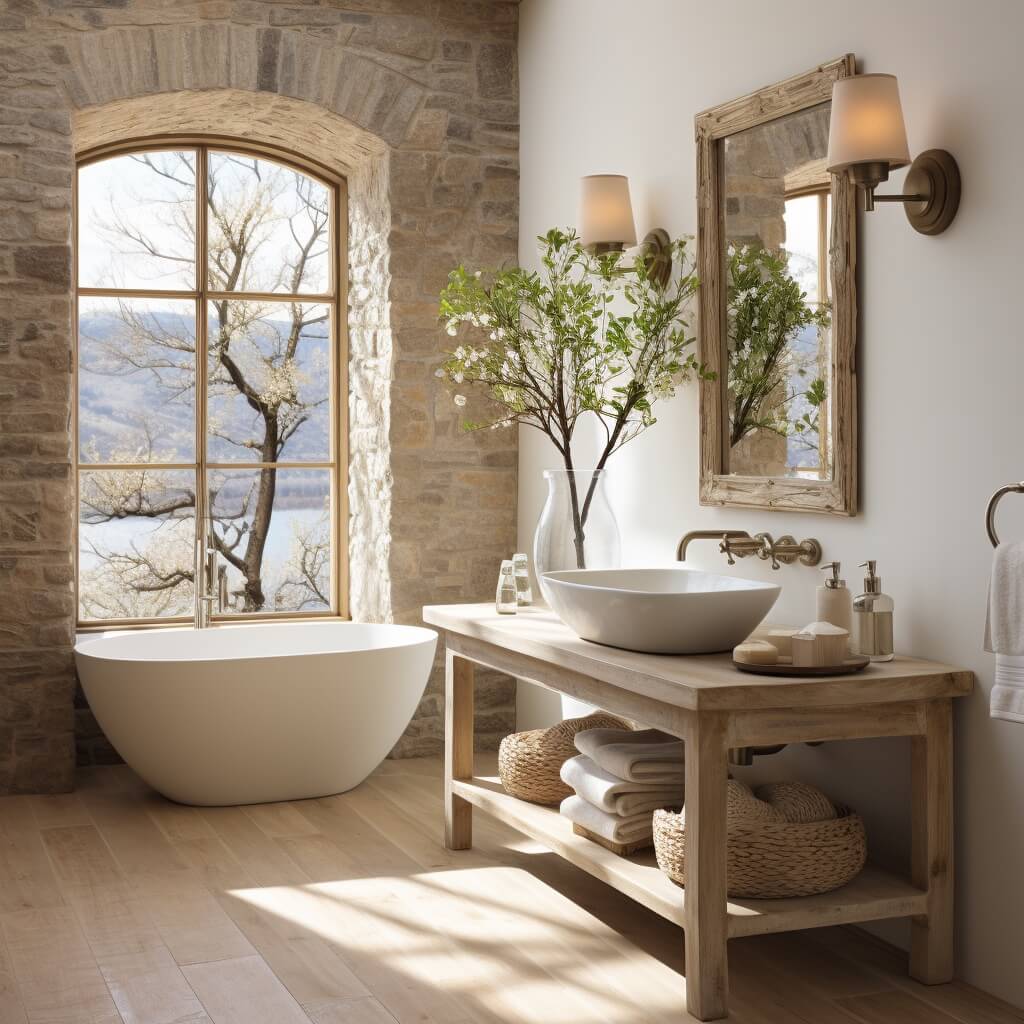
Pros
Cons
Advantages of Wooden Cabinets and Vanities for Bathrooms
Wooden cabinets and vanities can bring a sense of warmth and natural beauty to any bathroom. However, it’s important to be aware of the potential downsides. Here are some of the key disadvantages to consider:
| Disadvantages | Description |
|---|---|
| Sensitivity to Moisture and Humidity | Wood doesn’t fare well with continuous exposure to moist and humid environments, common in bathrooms. This can lead to damage over time. |
| Prone to Damage | The surface of wood can easily get marred by scratches, liquid spillages, and water splashes, which can affect its appearance and durability. |
| High Maintenance | Wood requires daily cleaning to protect it from moisture and humidity. This can be more demanding compared to other materials. |
| Susceptibility to Warping | Wood can warp, contract, or expand due to environmental changes. This can lead to structural issues and affect the longevity of the vanity. |
These are essential factors to consider when choosing wood for your bathroom vanity. While wood can bring a beautiful and natural look, the maintenance and care required to keep it in good condition might be a significant consideration.
Disadvantages of Wooden Cabinets and Vanities for Bathrooms
While wooden cabinets and vanities can add a warm and natural touch to your bathroom, they do come with a few drawbacks, especially when exposed to a bathroom’s typically moist and humid environment. Here are some of the main disadvantages:
| Disadvantages | Description |
|---|---|
| Moisture and Humidity Sensitivity | Wood doesn’t respond well to continuous exposure to moist and humid surroundings. This can lead to damage over time. |
| Vulnerability to Damage | The wooden surface can get marred by scratches, liquid spillages, and water splashes, which can affect its appearance and durability. |
| High Maintenance | Wood needs to be cleaned daily to safeguard it from moisture and humidity. This can be more demanding compared to other materials. |
| Susceptibility to Warping | The wood can warp, contract, or expand due to the changing environment. This can lead to structural issues and affect the longevity of the vanity. |
It’s important to consider these factors when choosing wood for your bathroom vanity. While it can provide a beautiful and natural look, the maintenance and care required to keep it in good condition might be a significant consideration.
Best Finish for Wood Bathroom Vanity Cabinet
You can employ numerous methods to give the desired finish to your wood bathroom vanity cabinet. Bring the focus on the vanity cabinet by using one of the following finishes.
Paint (Enamel)
Give your bathroom vanity cabinet a brand-new look with a few simple strokes of the brush. Enamel painting provides a gleaming coat that can withstand the hardships of a rough area. Start with one coat of paint followed by a light sanding after drying. Then apply a final coat of paint to get a long-lasting look.
Oil Stain
An oil-based stain provides the wood cabinets with a more durable and harder finish. Oils tend to seep into the wood, hardening the surfaces and protecting it from scratching and chipping too. It involves a long drying period along with a strong odor.
Lacquer
One of the most preferred cabinet finishes, lacquer can be applied easily, dries rather quickly and offers long-lasting protection. Three coats alternating with sanding will give you the best results and seal the bathroom cabinet as desired.
Best Wood for Bathroom Vanity And Cabinet FAQs.
How to Choose Wood for a Bathroom Vanity?
You use your bathroom vanity multiple times in a day starting from your morning ablutions to the time when you are calling it a day. So, the choice of wood requires some serious thought too.
You need to choose a wood that is aesthetically appealing, merges with your décor style and stays strong against the fluctuating wet and dry air of your bathroom. Let us go through the checklist.
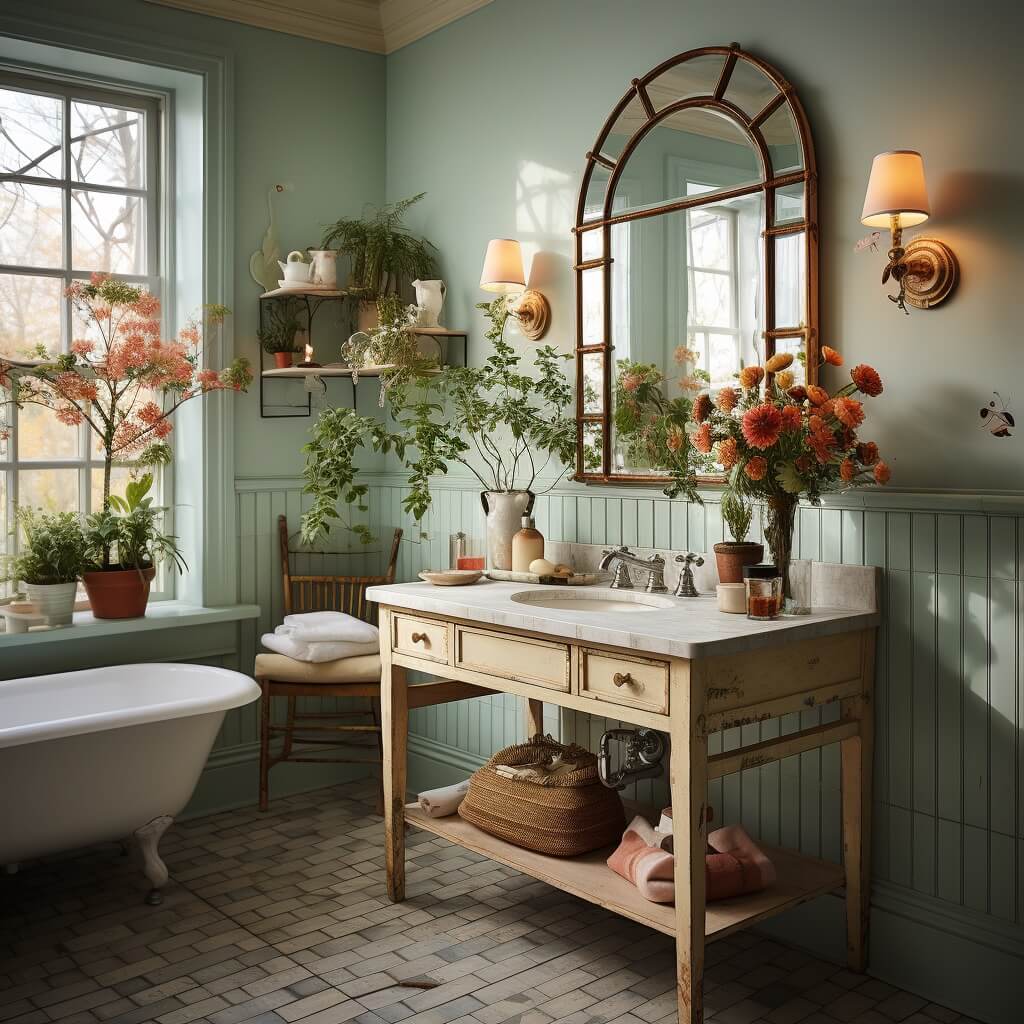
Review the Waterproof Capability
Bathrooms are mostly wet and foggy areas. The moisture and humidity stay in the bathroom air for a long time. Choose a wood that is likely to show the least deviation in highly humid and moist surroundings. Review the wood’s rot, warp and crack characteristics before making any selection.
Check the Durability
Well, no need to emphasize that you need to opt for the most sturdy and durable wood. Wood that works smoothly with stains and drills and can be shaped with ease should be your best bet.
Look for Moisture Content
With the aid of a moisture meter, you will be able to determine the moisture content of the wood at the time of purchase and delivery as well. Anything beyond the acceptable limits, and you can give the lot a wide berth.
Review the Humidity Levels
You need to observe the behavior of wood (warp, crooked, rot, cracks, etc.) after some time post-installation, as wood will take time to settle in its end-use environment.
What Should a Bathroom Vanity Be Made Out Of?
As a contractor, I’ve always been fascinated by the variety of materials that can be used to construct a bathroom vanity. The vanity, which typically includes a countertop, sink, and built-in shelves, can be customized in numerous ways to suit individual tastes and needs.
| Material Type | Description | Pros | Cons |
|---|---|---|---|
| Natural Stones (Granite, Slate, Soapstone) | These are naturally occurring stones that are cut and polished for use. | Durable, unique patterns, heat resistant | Can be expensive, requires sealing |
| Man-made Stones (Quartz, Artificial Stone, Solid Surface) | These are engineered stones made from a combination of materials such as cement, crushed stones, acrylic polymer, resin, and quartz. | Durable, customizable, non-porous | Can be expensive, not heat resistant |
| Metamorphic Stone (Marble or Carrara) | These are natural stones that have undergone transformation due to heat and pressure. | Luxurious, unique patterns, adds value to home | Expensive, porous, can stain |
| Porcelain | A type of ceramic that is fired at high temperatures to achieve a glassy texture. | Durable, non-porous, resistant to stains and scratches | Can chip or crack, professional installation required |
| Glass | Can be tempered for strength and is often used for modern, minimalist designs. | Modern look, easy to clean, non-porous | Can show water spots, can chip or crack |
| Thermoplastic Material (Acrylic) | A type of plastic that is durable and easy to mold. | Affordable, lightweight, easy to install | Can scratch, not heat resistant |
| Steel (Enameled and Stainless) | Metal sinks that are either coated with a layer of enamel or made from stainless steel. | Durable, easy to clean, heat resistant | Can show water spots, can dent |
It’s important to note that each material has its own unique set of characteristics, and the choice of material can greatly influence the overall look and functionality of the bathroom vanity.
From the elegance of natural and metamorphic stones, the versatility of man-made stones, the sleek modernity of glass and steel, to the affordability of thermoplastic materials, the options are vast and varied.
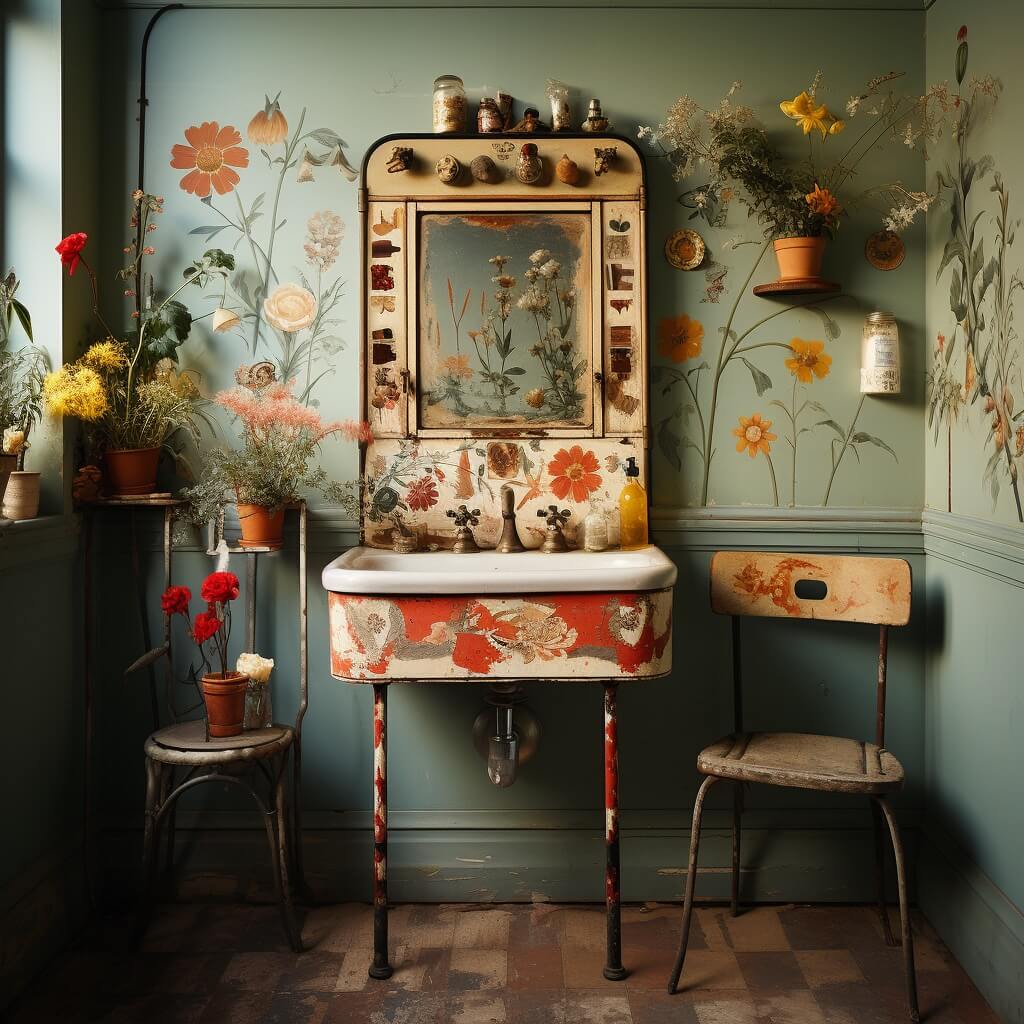
What Is the Best Material for Bathroom Cabinets?
Solid wood is generally considered the best material for bathroom cabinets because:
How Does Humidity Affect Bathroom Vanities?
Moisture and humidity do not sit well with your bathroom vanities. Water spillage from tubs, sinks and the pooling area of the shower is also detrimental to the long-lasting look of your vanities.
The bathroom vanities undergo an expansion in the humid air of the bathroom and show a shrinkage when the air becomes dry. They tend to warp in such conditions.
Other issues with humidity:
Splashes and spills from taps and showers can dribble down in the joints and hinges, leading to warping quite fast.
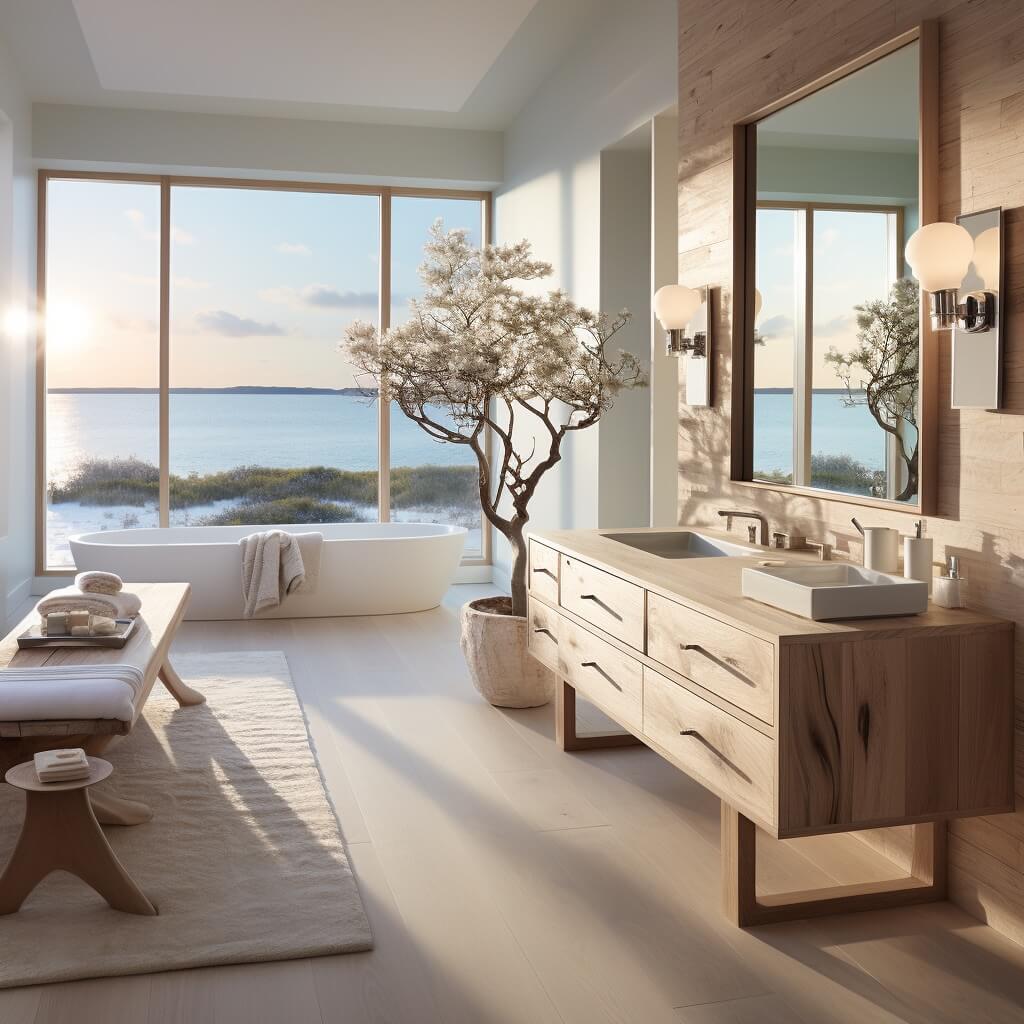
What Is the Best Budget Vanity Top Material?
When it comes to finding the most suitable and affordable vanity top material for those on a budget, laminate stands out as a top contender. Here’s why:
- Variety of Designs and Colors: One of the key advantages of laminate is its versatility. It comes in a wide array of designs and color shades, making it easy to match with any bathroom decor.
- Resemblance to Premium Materials: Laminate is cleverly designed to mimic the look of premium materials such as wood, marble, leather, and granite. This means you can achieve a high-end look without the high-end price tag.
- Ease of Maintenance: If you’re looking for a low-maintenance option, laminate is a great choice. It’s easy to clean and doesn’t require any special care or maintenance.
- Availability: Whether you’re looking for a ready-made solution or something more customized, laminate has you covered. It’s readily available in shops, and can also be customized according to your specific requirements by a professional.
Note, if you’re on a budget but still want a stylish and durable vanity top, laminate is a fantastic option to consider. It offers the best of both worlds: affordability and style.
In Conclusion
In choosing the best wood for bathroom vanity and cabinets, one must consider not only practical factors such as cost, durability, and moisture resistance but also the overall aesthetic appeal.
From the exquisite mahogany to the adaptable pine, there’s a spectrum of woods like teak, maple, birch, oak, MDF, elm, mango, and Douglas fir to fit your decor theme.
And remember, the beauty of working with wood extends beyond bathroom fixtures. The same thoughtfulness you’ve applied here can guide you when you’re selecting the best wood for bed frames or other home DIY projects. It’s all about embracing the versatility of wood and letting your creativity shine. Here’s to many successful DIY projects ahead!

